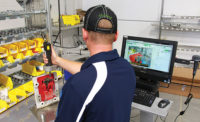Error-proof assembly is greatly assisted by error-proofing the setup process. By consistently organizing instructions, materials, tools and assembly equipment from workstation to workstation according to process, engineers will create a repeatable process that can be monitored and improved.
To best organize tools and materials, workstations should enable workers to easily arrange items at predetermined locations. This is most easily accomplished using a "hook and latch" mechanism that allows components to be attached and relocated without tools or hardware.
Locations for all the items that will be used in the assembly process should be similar for each assembler performing the same task, with the exception of appropriate ergonomic adjustments to suit each individual. For example, tools can be positioned on the workstation according to their usage sequence in the assembly cycle. However, assemblers should be able to move the tools to fit within their personal reach zones, without changing their order. When operators can reposition items such as tool holders, parts bins and document holders themselves without the need for tools, hardware or assistance, they tend to do so more often and will inherently improve their working conditions within the constraints of the assembly process. Improved ergonomics reduces fatigue, and fatigue is known to be a leading contributor to errors. Pick-to-light systems can greatly reduce errors by prompting operators which part to select from a bin, how many of the part to select, and what sequence to select the parts in. When an ergonomic workstation is combined with a parts delivery system that incorporates pick-to-light technology, a much more powerful production tool results. Not only do pick-to-light systems guide assemblers through each assembly step, but some systems can be integrated with the plant's materials resource planning system to track and adjust inventory as operators consume parts.
Color can also help in setting up a workstation. All the tools, fixtures and gauges that are used to support a specific assembly can be a similar color to ensure they are recognized as a kit. One example could be a torque-limiting screwdriver, a fixture and a custom gauge to check a clearance on a particular product. If any of these items was a different color than the others, the operator would know immediately that the wrong tool had been selected. A similar approach can be taken with parts bins and consumable items, such as adhesives.
To find out more about Arlink products, please call 888-559-4441 or email solutions@arlink.com.Visit the website at www.arlink.com.
